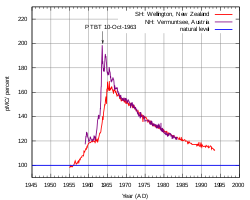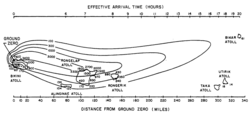Nuclear fallout

Fallout is the left over radiation hazard from a nuclear explosion. The name is because radioactive material "falls out" of the atmosphere into which it is spread during the explosion. These materials continue to undergo radioactive decay for minutes, days or centuries. "Fallout" commonly refers to the radioactive dust created when a nuclear weapon explodes. All nuclear explosions make fission products, which are the broken, radioactive atoms from a fission reaction. Neutrons from the explosion also make some nearby materials radioactive.
There was also radioactive fallout after a part of the nuclear power station at Chernobyl exploded. The fallout caused serious contamination over an area including Ukraine, Belarus, Russia, Scandinavia and some parts of Europe.[1] All people living in an area of 30 kilometres radius around the power plant were forced to move because of the fallout with villages and towns being abandoned.[1]
| Wikimedia Commons has media related to Lua error in Module:Commons_link at line 62: attempt to index field 'wikibase' (a nil value).. |
Nuclear Fallout Media
One of many possible fallout patterns mapped by the United States Federal Emergency Management Agency that could occur during a nuclear war (based on 1988 data)
Atmospheric nuclear weapon tests almost doubled the concentration of radioactive 14C in the Northern Hemisphere called the bomb pulse, before levels slowly declined following the Partial Test Ban Treaty.
The 450 km (280 mi) fallout plume from 15 megaton surface burst Castle Bravo, 1954."Estimated total (accumulated) dose contours in rads at 96 hours after the BRAVO test explosion"
Per capita thyroid doses in the continental United States resulting from all exposure routes from all atmospheric nuclear tests conducted at the Nevada Test Site from 1951 to 1962 and from emissions from plutonium production at the Hanford Site in Washington state
Fallout shelter sign on a building in New York City
Caesium-137 in Western European soil, from the Chernobyl disaster and its deposition through the weather
Plutonium-239 and -240 in soil, from nuclear weapons tests and its deposition through the weather
Public safety film created by the United States Office of Civil and Defense Mobilization from 1959
References
- ↑ 1.0 1.1 "Chernobyl | Chernobyl Accident | Chernobyl Disaster". world-nuclear.org. February 2011. Archived from the original on 1 March 2013. Retrieved 20 February 2011.







